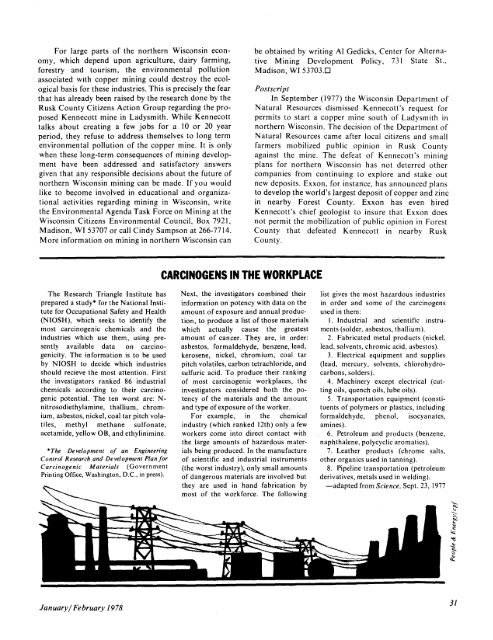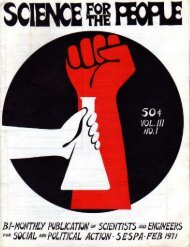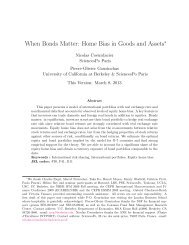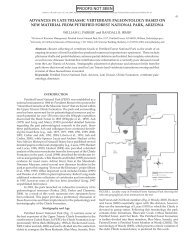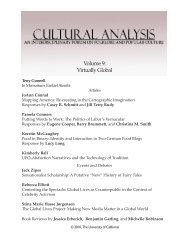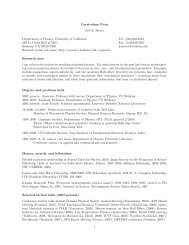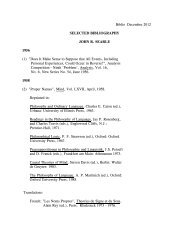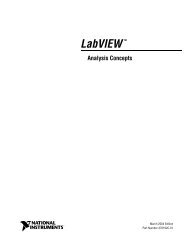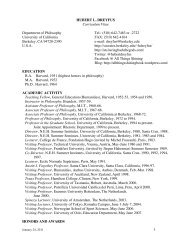Science for the People Magazine Vol. 10, No. 1
Science for the People Magazine Vol. 10, No. 1
Science for the People Magazine Vol. 10, No. 1
You also want an ePaper? Increase the reach of your titles
YUMPU automatically turns print PDFs into web optimized ePapers that Google loves.
For large parts of <strong>the</strong> nor<strong>the</strong>rn Wisconsin economy,<br />
which depend upon agriculture, dairy farming,<br />
<strong>for</strong>estry and tourism, <strong>the</strong> environmental pollution<br />
associated with copper mining could destroy <strong>the</strong> ecological<br />
basis <strong>for</strong> <strong>the</strong>se industries. This is precisely <strong>the</strong> fear<br />
that has already been raised by <strong>the</strong> research done by <strong>the</strong><br />
Rusk County Citizens Action Group regarding <strong>the</strong> proposed<br />
Kennecott mine in Ladysmith. While Kennecott<br />
talks about creating a few jobs <strong>for</strong> a <strong>10</strong> or 20 year<br />
period, <strong>the</strong>y refuse to address <strong>the</strong>mselves to long term<br />
environmental pollution of <strong>the</strong> copper mine. It is only<br />
when <strong>the</strong>se long-term consequences of mining development<br />
have been addressed and satisfactory answers<br />
given that any responsible decisions about <strong>the</strong> future of<br />
nor<strong>the</strong>rn Wisconsin mining can be made. If you would<br />
like to become involved in educational and organizational<br />
activities regarding mining in Wisconsin, write<br />
<strong>the</strong> Environmental Agenda Task Force on Mining at <strong>the</strong><br />
Wisconsin Citizens Environmental Council, Box 7921,<br />
Madison, WI 53707 or call Cindy Sampson at 266-7714.<br />
More in<strong>for</strong>mation on mining in nor<strong>the</strong>rn Wisconsin can<br />
The Research Triangle Institute has<br />
prepared a study* <strong>for</strong> <strong>the</strong> National Institute<br />
<strong>for</strong> Occupational Safety and Health<br />
(NIOSH), which seeks to identify <strong>the</strong><br />
most carcinogenic chemicals and <strong>the</strong><br />
industries which use <strong>the</strong>m, using presently<br />
available data on carcinogenicity.<br />
The in<strong>for</strong>mation is to be used<br />
by NIOSH to decide which industries<br />
should recieve <strong>the</strong> most attention. First<br />
<strong>the</strong> investigators ranked 86 industrial<br />
chemicals according to <strong>the</strong>ir carcinogenic<br />
potential. The ten worst are: Nnitrosodiethylamine,<br />
thallium, chromium,<br />
asbestos, nickel, coal tar pitch volatiles,<br />
methyl methane sulfonate,<br />
acetamide, yellow 08, and ethyl in imine.<br />
*The Development of an Engineering<br />
Control Research and Development Plan <strong>for</strong><br />
Carcinogenic Materials (Government<br />
Printing Office, Washington, D.C., in press).<br />
January/ February 1978<br />
CARCINOGENS IN THE WORKPLACE<br />
Next, <strong>the</strong> investigators combined <strong>the</strong>ir<br />
in<strong>for</strong>mation on potency with data on <strong>the</strong><br />
amount of exposure and annual production,<br />
to produce a list of those materials<br />
which actually cause <strong>the</strong> greatest<br />
amount of cancer. They are, in order:<br />
asbestos, <strong>for</strong>maldehyde, benzene, lead,<br />
kerosene, nickel, chromium, coal tar<br />
pitch volatiles, carbon tetrachloride, and<br />
sulfuric acid. To produce <strong>the</strong>ir ranking<br />
of most carcinogenic workplaces, <strong>the</strong><br />
investigators considered both <strong>the</strong> potency<br />
of <strong>the</strong> materials and <strong>the</strong> amount<br />
and type of exposure of <strong>the</strong> worker.<br />
For example, in <strong>the</strong> chemical<br />
industry (which ranked 12th) only a few<br />
workers come into direct contact with<br />
<strong>the</strong> large amounts of hazardous materials<br />
being produced. In <strong>the</strong> manufacture<br />
of scientific and industrial instruments<br />
(<strong>the</strong> worst industry), only small amounts<br />
of dangerous materials are involved but<br />
<strong>the</strong>y are used in hand fabrication by<br />
most of <strong>the</strong> work<strong>for</strong>ce. The following<br />
be obtained by writing AI Gedicks, Center <strong>for</strong> Alternative<br />
Mining Development Policy, 731 State St.,<br />
Madison, WI 53703.0<br />
Postscript<br />
In September (1977) <strong>the</strong> Wisconsin Department of<br />
Natural Resources dismissed Kennecott's request <strong>for</strong><br />
permits to start a copper mine south of Ladysmith in<br />
nor<strong>the</strong>rn Wisconsin. The decision of <strong>the</strong> Department of<br />
Natural Resources came after local citizens and small<br />
farmers mobilized public opinion in Rusk County<br />
against <strong>the</strong> mine. The defeat of Kennecott's mining<br />
plans <strong>for</strong> nor<strong>the</strong>rn Wisconsin has not deterred o<strong>the</strong>r<br />
companies from continuing to explore and stake out<br />
new deposits. Exxon, <strong>for</strong> instance, has announced plans<br />
to develop <strong>the</strong> world's largest deposit of copper and zinc<br />
in nearby Forest County. Exxon has even hired<br />
Kennecott's chief geologist to insure that Exxon does<br />
not permit <strong>the</strong> mobilization of public opinion in Forest<br />
County that defeated Kennecott in nearby Rusk<br />
County.<br />
list gives <strong>the</strong> most hazardous industries<br />
in order and some of <strong>the</strong> carcinogens<br />
used in <strong>the</strong>m:<br />
I. Industrial and scientific instruments<br />
(solder, asbestos, thallium).<br />
2. Fabricated metal products (nickel,<br />
lead, solvents, chromic acid, asbestos).<br />
3. Electrical equipment and supplies<br />
(lead, mercury, solvents, chlorohydrocarbons,<br />
solders).<br />
4. Machinery except electrical (cutting<br />
oils, quench oils, lube oils).<br />
5. Transportation equipment (constituents<br />
of polymers or plastics, including<br />
<strong>for</strong>maldehyde, phenol, isocyanates,<br />
amines).<br />
6. Petroleum and products (benzene,<br />
naphthalene, polycyclic aromatics).<br />
7. Lea<strong>the</strong>r products (chrome salts,<br />
o<strong>the</strong>r organics used in tanning).<br />
8. Pipeline transportation (petroleum<br />
derivatives, metals used in welding).<br />
-adapted from <strong>Science</strong>, Sept. 23, 1977<br />
31


